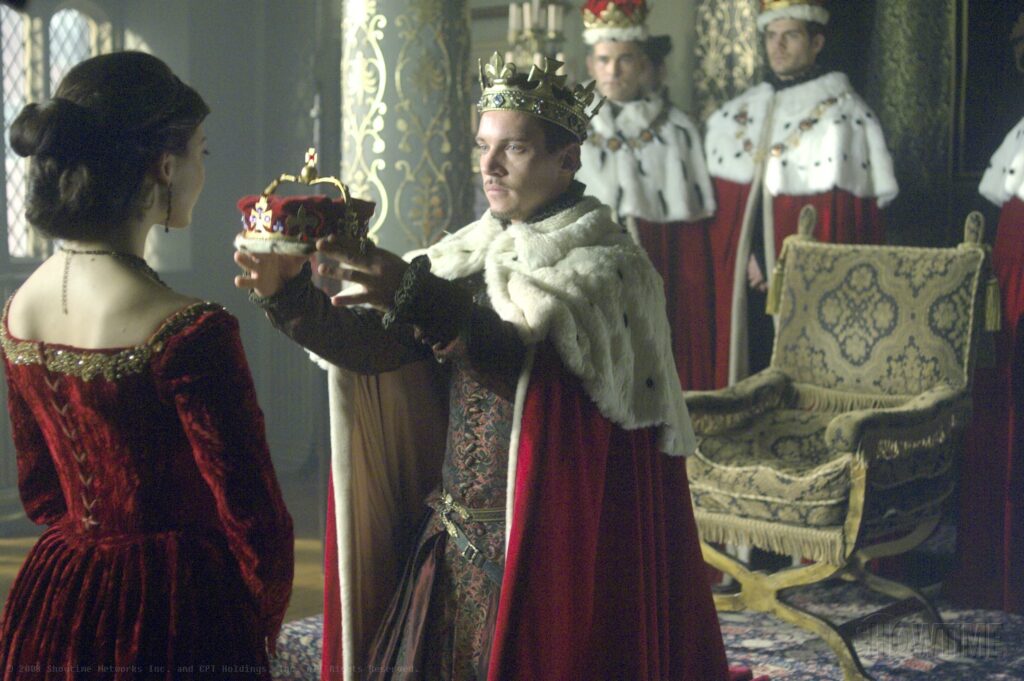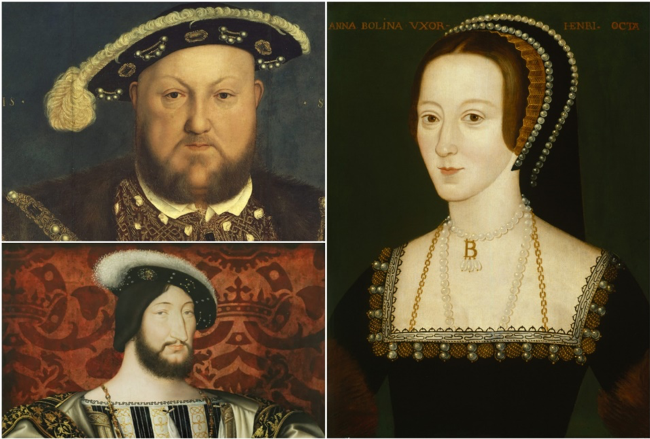Imagine that we are in the city of Calais during the time of Tudor England. This place had a special meaning for King Henry VIII because it was the last remnant of the once substantial English possessions on the continent. King Henry and his beloved Anne Boleyn sailed to Calais to meet with King François I of France, whose support they wanted to secure for their marriage. The route from Dover to Calais was the shortest crossing point of the English Channel.
In the 16th century, Calais was both a trading city and a port. Encircled by thick, fortified walls, the city consisted of narrow streets, lanes, and squares, as well as houses of wealthy merchants and the humble homes of ordinary people. Today, only a few medieval traces remain, including the Tour du Guet (watchtower), which is the city’s oldest surviving building. It is located at the heart of what is now called the Calais Nord quarter.

The city of Calais under Tudor rule.
The city was ruled by the Lord Deputy of Calais, who maintained the city’s garrison. Between 1533 and 1540, King Edward IV of England’s illegitimate son, Arthur Plantagenet, Viscount Lisle, served as Lord Deputy of Calais. During the reign of Henry VIII, significant improvements to the city’s defence system were completed in the 1540s.
Let’s remember what preceded Anne and Henry’s arrival in Calais. In June 1532, England and France had signed an alliance treaty; one of the many meaningless documents signed between England and France during the reigns of François I and Henry VIII. Expecting François’ support in getting his matrimony with Catherine of Aragon annulled, Henry had negotiated with François to meet at Calais in autumn of 1532.
The agenda had been defined: discussions of Henry’s remarriage to Anne Boleyn and the two countries’ policies against their common enemy, Emperor Charles V. In August, Henry and Anne had gone on an excursion with his court through the English southern counties, but the monarch had been compelled to shorten their journey due to the populace’s hostility towards his beloved. The people had reportedly lined the roadsides and hurled verbal insults at Anne, appealing to their sovereign to take Catherine back as his wife. Around this time, Anne discovered a book of prophecies with a picture depicting her headless in her apartments at Whitehall, which had been left by one of her enemies, but Anne had dismissed it as nonsense.
Anne told her maid of honor, Lady Anne Saville, that she resolved to marry the ruler:
“That my issue may be royal, whatever will become of me.”
On the 22nd of August 1532, Archbishop Warham had died, and the king appointed Thomas Cranmer Archbishop of Canterbury. Cranmer was backed by the Boleyn faction and had a genuine affection for Anne. On the 1st of September, the monarch had bestowed upon Anne a peerage in her own right in an elaborate ceremony at Windsor Castle. Anne had been created Marquess of Pembroke, using the male style of this title that had once belonged to Henry’s Tudor ancestors.

Anne’s status had been enhanced for the couple’s French visit and to set the stage for Henry’s future marriage not to an English earl’s daughter, but to a high-ranking peeress. Anne then openly assembled a court around her, but the old English nobility were not its members, and they quietly resented her. Anne’s court included her brother, George Boleyn, Viscount Rochford, his wife Jane Boleyn née Parker, Sir Francis Bryan, William Brereton, Sir Thomas Wyatt (who was her old admirer), Sir Francis Weston, and a few others.

Even before their departure for Calais, the matter of which royal lady would receive Anne during the visit had been a subject of debates between two kings. Henry had refused to see Queen Eleanor, who was the emperor’s elder sister and Catherine’s niece; Eleanor had categorically denied the possibility of going to Calais, which was shameful in her opinion. To Anne’s chagrin, Queen Marguerite of Navarre (Marguerite d’Angoulême) had also not consented to come, despite Marguerite’s affection for Anne, who seems to have once been part of her literary circles. Since Marguerite could not associate herself with the “Scandal of Christendom”, François had suggested that his maîtresse-en-titre, Anne de Pisseleu d’Heilly, Duchess d’Étampes, would greet Anne in Calais, but Henry had protested. While Henry viewed Anne as his bride, François and the rest of Catholic Europe saw her as the Tudor ruler’s mistress. It had been decided that Anne would remain in Calais while Henry would meet with his French counterpart in Boulogne.
On the 7th of October, Henry and Anne began their voyage to Dover with their vast train. By the 10th, the king and his beloved had sailed to Calais on a ship called “The Swallow.” Such a banal name for the vessel that carried Anne and Henry to their “ally!” Superstitious minds might perceive it as a sign that either Henry’s passion or his huge ego would eventually swallow Anne completely. The journey took seven hours. They were welcomed in Calais by civic dignitaries and the Governor, and then they went to the Church of St Nicholas, where they attended Mass.

Anne had visited Calais at least once before, when she had crossed the Channel on the way back to England in the early 1520s as a young woman who had learned French manners and likely missed the sophisticated splendor of the Valois court. The people’s greetings in Calais must have been a stark contrast to the hostility from the English folk, which Anne had experienced during the royal progress a few months ago. Anne de Montmorency, Constable of France, sent to the couple many gifts of food.
In Calais, King Henry and Anne both resided at the Exchequer Palace. It is remarkable that their bedrooms were connected, so some historians think that the couple had already been intimate at the time, and that Anne had surrendered to Henry’s passions after her ennoblement. Personally, I do not think so. I believe Anne and Henry became lovers shortly after their visit to Calais or in Calais after the last banquet in honor of King François I of France.
By Olivia Longueville
References
- ‘The chronicle of Calais in the reigns of Henry VII and Henry VIII, to the year 1540.”
- ‘The Life and Death of Anne Boleyn’ by Eric Ives, 2004.
- ‘Six Wives: The Queens of Henry’ by David Starkey, 2004.
- The Harleain Manuscripts (Harley MS 303) in the British Library.
http://www.bl.uk/catalogues/illuminatedmanuscripts/record.asp?MSID=4058&CollID=8&NStart=303
About the Author
Olivia has always loved literature and fiction, and she is passionate about historical research, genealogy, and the arts. She has several degrees in finance & general management from London Business School (LBS) and other universities. At present, she helps her father run the family business.
During her first trip to France at the age of ten, Olivia had a life-changing epiphany when she visited the magnificent Château de Fontainebleau and toured its library. This truly transformed her life as she realized her passion for books and writing, foreshadowing her future career as a writer. In childhood, she began writing stories and poems in different languages. Loving writing more than anything else in her life, Olivia has resolved to devote her life to creating historical fiction novels. She has a special interest in the history of France and England.
Olivia’s social media profiles:
Personal website: www.olivialongueville.com
Project website: www.angevinworld.com
Twitter: @O_Longueville
Facebook: https://www.facebook.com/ovlmoscow
Tumblr: www.olivia-longueville.tumblr.com















Latest Comments